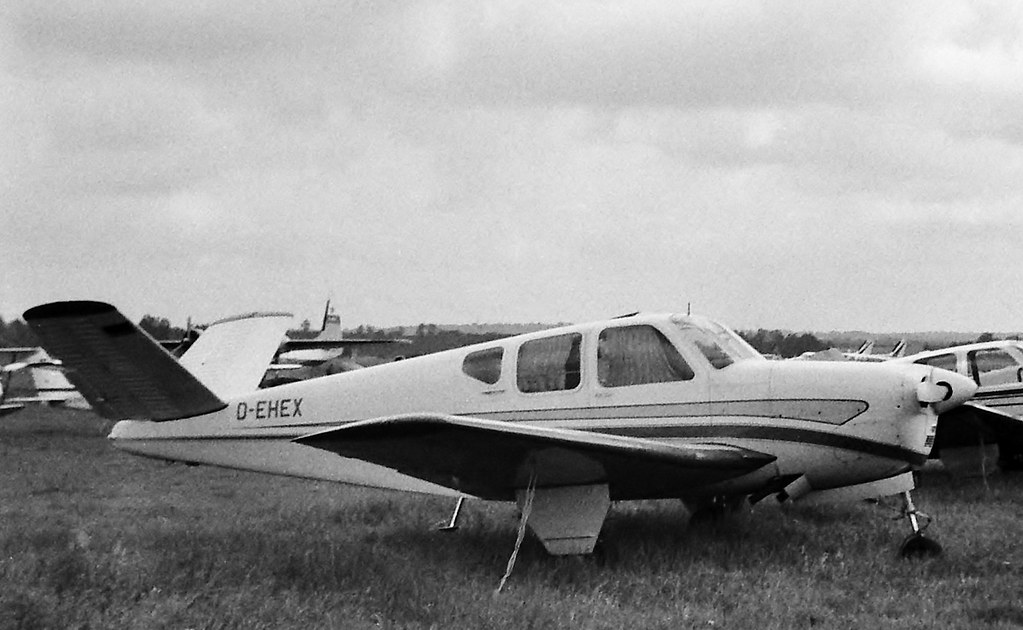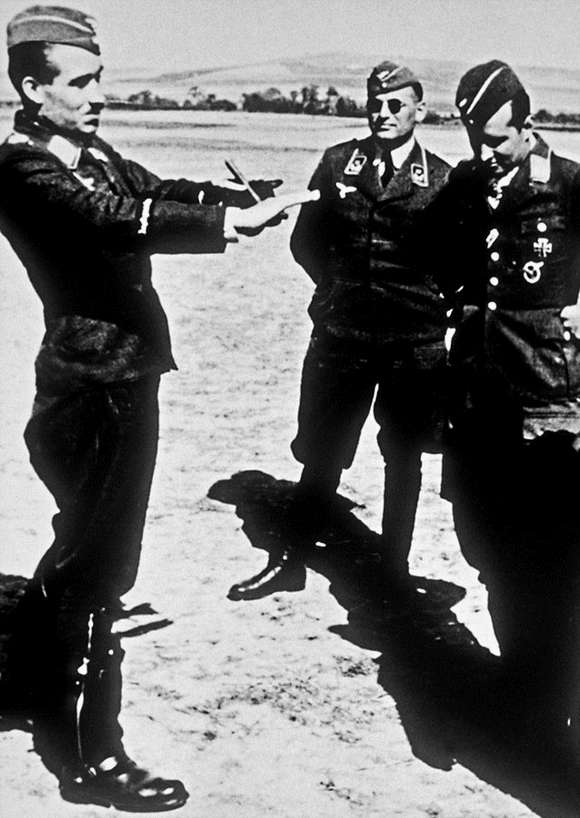2/9/1996 - The tumultuous flying career and life of Adolf Josef Ferdinand "Dolfo" Galland, Jr. concludes when the former fighter pilot and Luftwaffe commander dies from a heart ailment in his Oberwinter, Germany home at the age of 83.
Galland's very eventful summer continues with more combat patrols victories, but no further visits to the hospital, hours of mission planning, and on August 9, 1941, he and his pilots play chivalrous hosts to RAF star pilot, legless Group Captain Douglas Bader (the British ace has 22 aerial victories at the time); there will be a lavish meal served to the Luftwaffe's prisoner, a tour of the air base, the British pilot will be allowed to sit in the cockpit of a Bf 109 fighter (the two men will joke back and forth about Bader taking the fighter up for a quick fly around the airfield ... remembering the respect he is shown, Bader will become a great friend of Galland's after the war), and with Goering's approval, Galland arranges for the RAF to drop a replacement artificial leg to the English fighter pilot; an artificial leg which Bader soon uses to stage the first of his many escape attempts of WWII (Bader will end the war confined with other fighter pilots in Coldwitz Castle). Back to his normal routines once Bader is captured again and sent off to a German POW camp, Galland shoots down two Spitfires and a Hurricane on the 19th of August, becoming Germany's highest scoring ace of all-time (but not for long once the Luftwaffe starts chewing up the inferior planes and pilots of the Soviet Union) when he surpasses Baron Manfred von Richthofen's WWI tally of 80 aerial victories with his 81st triumph. Once autumn arrives, Galland adds 15 more RAF planes to raise his tally to 96 victories with yet another Spitfire downed on November 18, 1941, but there his official tally will remain for the next three years.
Things finally come to a head between the two men in late 1944 and early 1945 with the Reich being bombed by the Americans and English around-the-clock every day of the week as Hitler pulls the plug on Galland's "Big Blow" plan in which over 2,500 fighters horded for massive German strikes against the massed American bombers over the Reich (Galland estimates his flier's will knock 500 bombers down) and instead channels the force into supporting an offensive in the Ardennes meant to drive a wedge between the advancing British and American armies that becomes the Battle of the Bulge. At the same time, a Luftwaffe rival, Oberslieutnant Gordon Gollob (he will end the war credited with shooting down 150 enemy planes flying over 340 combat missions) involves SS Reichsfuhrer Heinrich Himmler (he wants the new Me 262 jets to fly and fight under the SS banner) in the Luftwaffe's internal power struggles by providing the mass murderer with false claims about Galland's womanizing, drinking, misuse of equipment and lack of courage. Given the opportunity to remove a long-time thorn in his side, while preventing his power rival Himmler from involving himself in taking over the air force, Goering relieves Galland of his command on January 13, 1945 (giving Gollob the job) and sends him off to the seclusion of the Harz Mountains on "vacation" (the public is told he is recovering from a wound), where the flier is effectively placed under house arrest. Beloved by a host of fellow German fighter pilots, the reaction to Galland's removal is swift. On January 17, 1945, a small group of high-ranking fighter pilots meets with Goering at the Haus der Flieger (formerly the Prussian House of Lords) in Berlin to protest the firing and other flight issues. Among the protestors are spokesperson Gunter Lutzow, Oberst Johannes "Hannes" Otto Trautloft (he will be credited with 58 aerial victories by the war's end and dies in Bavaria at the age of 82 in 1995), Oberst Eduard Neumann (an ace with 13 aerial victories and commander of the legendary JG 27 fighter squadron, he dies in Munich in 2004 at the age of 93), Oberst Gustav Rodel (at the war's end he will have 98 victories to his credit, he dies in 1995 at Bonn-Bad Godesberg), and Oberst Johannes "Macky" Steinhoff (he ends WWII with 178 aerial victories to his credit, and dies in Westphalia in 1994 at the age of 80). Angered by what he believes is gross insubordination, Goering wants to shot all the protestors (and Galland who he believes has instigated what will be known as The Fighter Pilot's Revolt), but holds off starting a blood bath among his own men without Hitler's approval (and evidence backing up the claims of treason) ... which luckily for Galland is not forthcoming. Recognizing the foolishness of removing highly trained pilots from his air force when they are vitally needed and already in short supply, Hitler tells Goering to back off (his exact words are to "stop all this nonsense") and put Galland in charge of creating the world's first fighter squadron of jets.
Ordered to Karinhall, Goering's large hunting estate in the Schorfheide Forest northeast of Berlin, Galland is offered the command of Jagdverband 44, and he wisely accepts with one caveat, Gollob is to have no say in how he runs his group, which the Luftwaffe Reichsmarschall agrees to (Goering will tell Galland that he wishes he wasn't so corpulent so that he could fit into a Me 262 and combat fly with Galland on his attacks on the American bomber streams and their P51 escort fighters when he meets with the flier for the last time of 4/21/1945). And so, the final acts of Galland's WWII flying adventures begin on February 22, 1945 with the jet fighter unit's official creation (he begins with sixteen operational jets and fifteen pilots, numbers that get slightly beefed up when General Josef Kammhuber releases a handful of pilots and planes from two bomber wings that are training on the jets as bombers). Setting up at an airfield near Munich, twelve jet fighters fly the group's first mission on April 5, 1945, shooting down three American B-17 bombers. Official count halted when Galland was made head of all the Reich's fighter plane, the pilot finally adds to his total kills when flying an Me 262 jet, the ace shoots down two American Martin B-26 Marauder bombers. Towards the end of April, Galland has a six day period in which his friend, Steinhoff survives crashing on takeoff when a tire blowout and collision with another jet sends the ace careening off the runway (turned into a "human torch," the flier will suffer massive burns over his entire body that keep him in the hospital for two years and require years of reconstructive surgery, including a British surgeon rebuilding his eyelids ... amazingly, he will become a general in the West German air force in 1960), Lutzow goes missing on the 24th of the month while diving away from two Republic P-47 Thunderbolt fighters escorting a B-26 American bomber mission, and in between the two losses of friends under his command, the ace becomes the 103rd and last German pilot to score 100 aerial victories (the last of any nation in the war, and maybe the last of all time given the changes that have taken place in aerial warfare).
Health beginning to fail as he reaches his 80s, Galland retires to his home in Oberwinter, Germany (first married to Countess Von Donhoff, the couple divorce in 1963, Galland weds a second time in 1963, on the very day his divorce becomes official, marrying his secretary, Hannelies Ladwein, a union that will produce his son, Andreas Hubertus, in 1966, and his daughter, Alexandra-Isabelle, in 1969 ... once a hound dog, always a hound dog, when his second marriage fails, he marries for a third and last time to Heidi Horn, who remains with him until his death). Hospitalized with a myriad of health issues, Galland convinces his doctors to let him pass away at home, and with wife, son, and daughter present, the fighter pilot receives the Catholic Church's last rites before passing away from heart failure at 1:15 in the morning on Friday, February 9, 1996. His spirit off on one of Heaven's clouds somewhere discussing flying with other pilots, Galland's body is buried in Oberwinter's cemetery on February 21st.































































